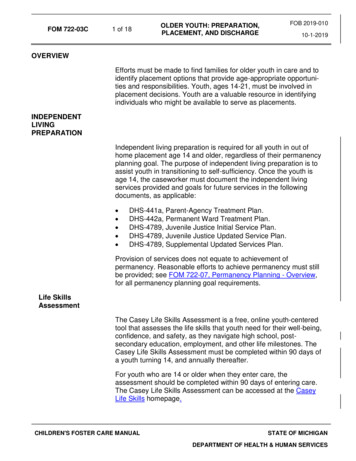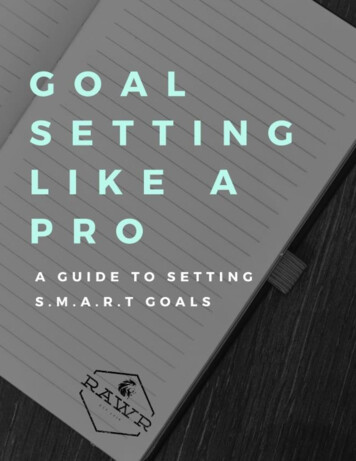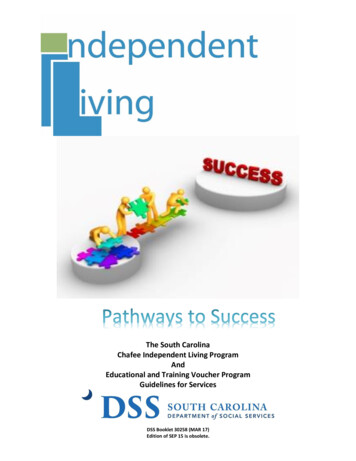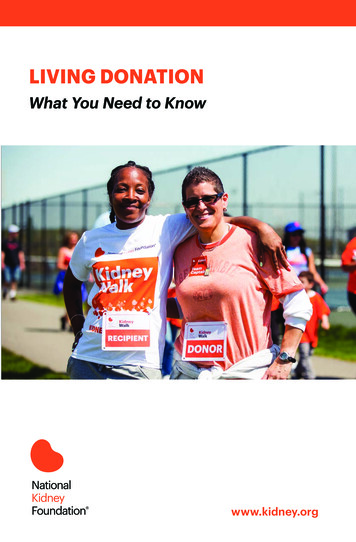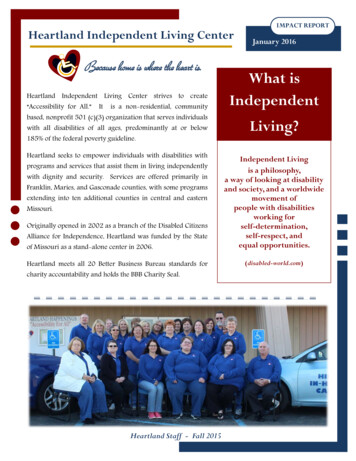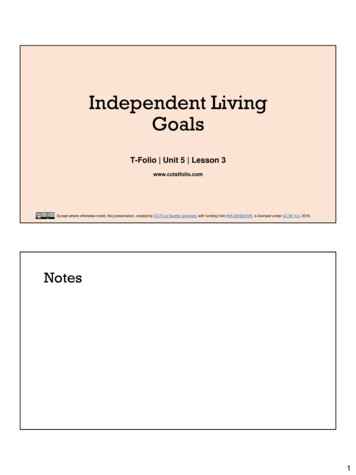
Transcription
Independent LivingGoalsT-Folio Unit 5 Lesson 3www.cctstfolio.comExcept where otherwise noted, this presentation, created by CCTS at Seattle University with funding from WA DSHS/DVR, is licensed under CC BY 4.0, 2018.Notes1
Lesson ObjectivesYou will:1. Review a variety of independent living skills.2. Identify your level of independence in terms of possessingidentified skills.3. Set SMART goals to improve areas of need.Except where otherwise noted, this presentation, created by CCTS at Seattle University with funding from WA DSHS/DVR, is licensed under CC BY 4.0, 2017.Notes2
Warm Up: A-Z ActivityOpen the A-Z forIndependent LivingactivityABCDEFGHIJKLMNOPQRSTUVWXYZExcept where otherwise noted, this presentation, created by CCTS at Seattle University with funding from WA DSHS/DVR, is licensed under CC BY 4.0, 2018.NotesSay: We are going to complete an A-Z Activity for Independent Living. Generate asmany ideas around independent living as you can in three minutes.For example, you may write “apartment” for A or “using a debit card” for U. Set a timer for three minutes and allow students to complete the A-Z Activityeither online or on paper.Have students share out responses round robin. Consider completing anotherlist on the board as students share out their responses to allow students to fill inany letters they did not complete during the timed activity.A sample is started on the next slide.3
Sample Start to A-Z ActivityAApartmentBBus for transportationCCooking own mealsDDebit card for purchasesEEager to live on ownFFinancially independentGExcept where otherwise noted, this presentation, created by CCTS at Seattle University with funding from WA DSHS/DVR, is licensed under CC BY 4.0, 2018.NotesHere are some sample words or terms to get the group started, if needed.4
Independent Living AssessmentDirections: Open the Independent Living Assessment. Revieweach statement and consider whether you possess the identifiedskills. Check the box that corresponds to your answer using thefollowing guide: Always – You are able to perform this skill independentlyand consistently. Sometimes – You are sometimes able to perform this skillindependently. Never – You are not able to perform this skill consistently ornot at all.Except where otherwise noted, this presentation, created by CCTS at Seattle University with funding from WA DSHS/DVR, is licensed under CC BY 4.0, 2018.NotesSay: Now we are going to complete an Independent Living Assessment. (Prompt studentsto access assessment either electronically or in paper form.) You will review eachstatement and consider whether you possess the identified skills. Think carefully aboutwhether you always, sometimes, or never perform the skill. Only mark “always” if you canperform the skill independently without support and on a consistent basis. For example, ifyou successfully used a debit card one time, then your response would be “sometimes”because you are not yet using a debit card consistently. Model completing the first section on daily living skills, providing examples of when tocheck never, sometimes, or always.Give students time to complete the remainder of the assessment independently.Discuss the debrief and guiding questions below prior to having students write 2-3SMART goals.5
Debrief and Guiding Questions Are there areas of independent living skills where youresponded “Always” to every prompt? Look over the questions that you responded “Never” to. Whatdo you need to do to be able to respond to those prompts with“Sometimes” or “Always”? What area(s) of independent living do you need to improve in? Are there areas of independent living you should prioritize firstin order to be set up for success after high school?Except where otherwise noted, this presentation, created by CCTS at Seattle University with funding from WA DSHS/DVR, is licensed under CC BY 4.0, 2018.NotesAsk: Are there areas of independent living skills where you responded“Always” to every prompt? Look over the questions that you responded “Never” to. What do youneed to do to be able to respond to those prompts with “Sometimes” or“Always”? What area(s) of independent living do you need to improve in? Are there areas of independent living you should prioritize first in order tobe set up for success after high school?Say: Next, you will write 2 or 3 SMART goals in the area(s) you identifiedfor improvement.6
Setting GoalsOpen the Independent Living Goals Worksheet.GoalFirst StepDate to HaveCompleteWhat SupportWill You Need?1.2.3.Except where otherwise noted, this presentation, created by CCTS at Seattle University with funding from WA DSHS/DVR, is licensed under CC BY 4.0, 2018.NotesSay: Using the Independent Living Goals Worksheet, write 2 or 3SMART goals in the area(s) you identified for improvement in order to worktowards independence after high school. Refer back to Unit 2 Lesson 1 to remind students how to write a SMARTgoal, if needed.7
Licensing & CopyrightExternal linksThis resource may contain links to websites operated by third parties. These linksare provided for your convenience only and do not constitute or imply anyendorsement or monitoring. Please confirm the license status of any third-partyresources and understand their terms of use before reusing them.LicensingExcept where otherwise noted, this work, created by Center for Change inTransition Services at Seattle University with funding from Washington StateDivision of Social and Health Services/Division of Vocational Rehabilitation, islicensed under a Creative Commons Attribution License. All logos and trademarksare property of their respective owners.For more details on T-Folio’s licensing policy, please visit: www.cctstfolio.com8
Independent Living activity Notes Say: We are going to complete an A-Z Activity for Independent Living. Generate as many ideas around independent living as you can in three minutes. For example, you may write "apartment" for A or "using a debit card" for U. Set a timer for three minutes and allow students to complete the A-Z Activity
